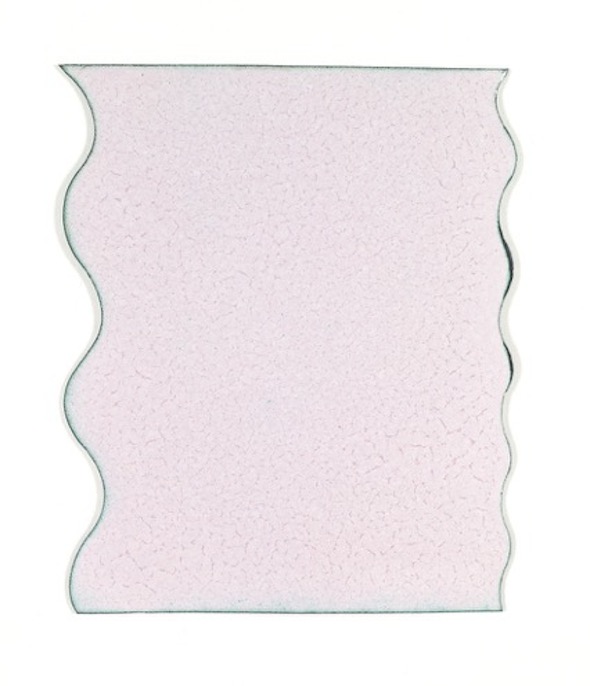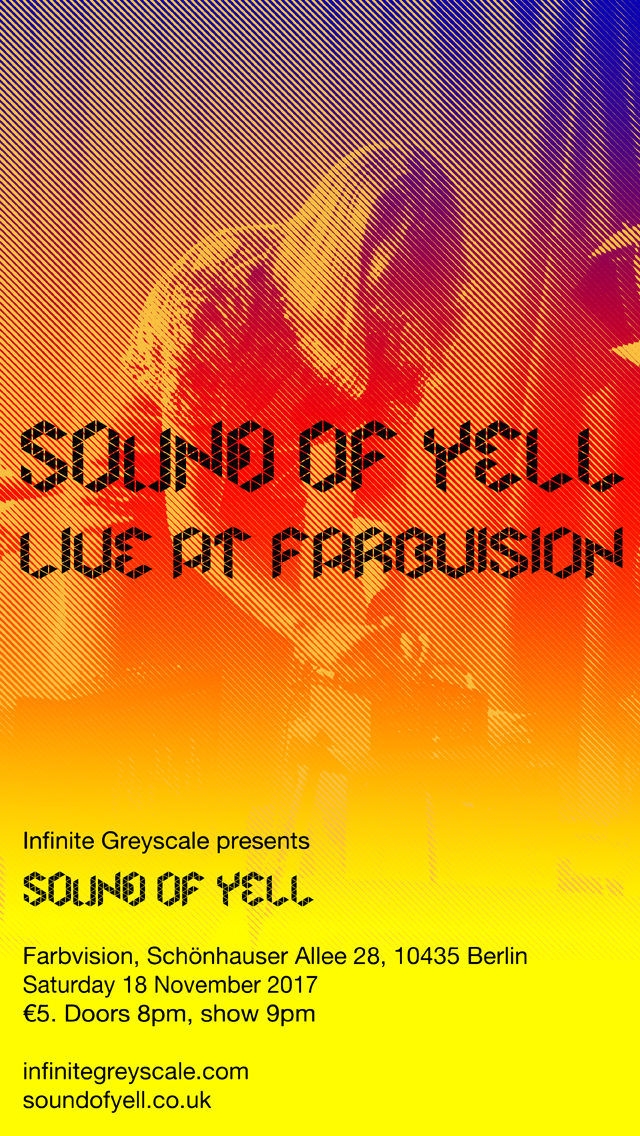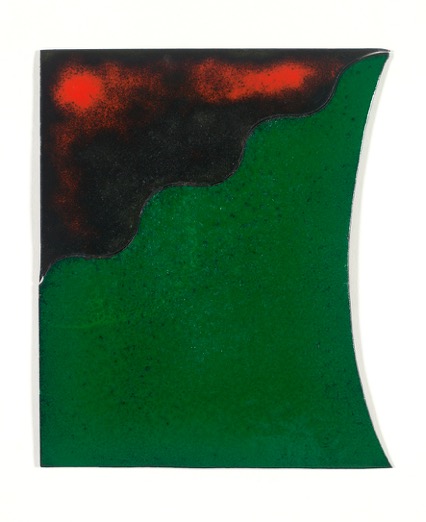Have you met... Farbvision
Have you met... Farbvision
We met with artist Paul McDevitt, who runs Farbvision – an elaborately tiled storefront space in which he invites individual artists to present focused exhibitions of their work. With its multi-layered past, some of which is still visible, the space itself reflects McDevitt's aims to foster an environment for experimentation and crossovers of different media and formats. Farbvision's next exhibition opens tomorrow, 17 November, and will feature new work by Alexander Wagner, which interacts with and builds upon the found surfaces of the space.
Let's start with how Farbvision came about. Once in the space, you discovered its hidden architectural past. Is this what prompted the project initially?
I do an irregular series of exhibitions with another artist, Declan Clarke, and over the years we’ve done exhibitions in different spaces and we’d been talking a bit about running a space for a year or two, as a one-off thing. So, I had it in the back of my mind, but starting this space was very impulsive. We took the space two years ago and discovered, hidden beneath foam board walls, this old tiled shop, which I assume was a butcher’s shop, perhaps 100 years ago. More recently, it had been a copy shop. The name Farbvision comes from the old sign – the outside had the slogan and name and I just peeled off the vinyl letters one by one until I got something that stuck. I thought Farbvision was quite nice – it’s easy to say in different languages, fairly easily translatable and open. I even liked where it was on the light box outside: off to one side and sort of discreet. That’s how it started, and then I became interested in the idea of tying together, not just being an artist and having a space, but I make risograph editions, working closely with the artists. It’s only me who invites people, and there are no submissions permitted. It’s an extension of the practice. I also have a record label that I run with another artist, Cornelius Quabeck, and we tie in the label in some ways. We do the printing downstairs for the covers and the inserts – it’s all very DIY. We try to have crossovers with some of the live events, so the concert this Saturday is one of our most recent records, by a Glasgow band, Sound of Yell.
Did you have an interest in local history before finding this space, or was this interest sparked by it?
I had a very strong interest. The space I had before was a studio on the ground floor of a residential house. I had found it very much by chance, and the landlord was keen to have an artist in the building, because there had been a history of experimental artistic practice in the house. There was a private gallery there – the first one in the DDR. It was the first space in the country to show video art; the first place that A.R. Penck showed before he went to the west. The Stasi had tried to close it down through various nefarious means. A great story, but, unfortunately, before she died, the Hausmeisterin burned all of her documents, so there’s no recorded history of who she had in the house during the 60s, 70s and 80s. The current owner seems to like having artists around. I always wanted to celebrate that in some way, but just never figured out how. I suppose, in a roundabout way, that’s what it became here – at a different address, but similar location. There was obviously a lot going on in this area, before the wall came down. A lot of it was gentrified away, but I think there are little spaces here: there’s tête across the road; there’s die raum on the corner. A lot of things closed down 10 years ago as people bought houses and it became a fancy area, but I think there’s a slightly rougher edge creeping back in, and it needs it. It’s a little bit of an in between area.

What's the concept behind, or what informs, Farbvision's program?
What I really want to do with the space is compete – or rather, operate on the same level – as a big commercial gallery. I have no money behind it, but I can show the same artists and have the same level of ambition. I’m not really into doing group shows, but solo gestures, or very clear statements from individuals. And it’s partly a generational thing: most people I show here are people I know who have been around for a while, so they have an existing practice, and then they get to put their work in a very different environment. I really fancy showing very established names and having them get a little bit back to their roots, in almost a laboratory environment: doing something simple, trying something out in a different space. I think with the very decoratively tiled walls, it’s such a heavily accented space already; an artist can easily put one piece on the wall and it would hold the room. Maybe I don’t have a great deal to offer, but I can create an environment where they can try something exciting.
You exhibit artists working across various media. How often are the walls – seeing as they are so elaborate – part of the installation, or are wall-based works exhibited? Are many artists creating site-specific work for the space, or how do they otherwise choose to work with it?
Many artists are creating site-specific work – though not necessarily, and it’s completely open and up to them. There’s also a certain percentage of people who are quite resistant to the walls at first. They think of ways to protect themselves from the decorative tiles, by putting another background behind or framing their work. But most give in when they enter the space, or start installing. Usually it works out that most people showing here install their work as it would be anywhere else and, in the end, it just makes the work look different. Every other time you see that work it will probably be on a white wall. That’s the thing about the space: it’s an usual space that lends a different energy to all the work that’s in here. Most artists have been quite excited and surprised by seeing their work in this environment.

Sound is also an important component of the work produced and exhibited here.
Yes, I like to do crossovers with Corneilus Quabeck. I did a show here with an Israeli artist, Yair Elazar Glotman, who’s a musician and sound artist. He’ll be a future release on our record label. During the next exhibition, opening Friday, we’ll have a special event the day after with Glasgow artist band Sound of Yell. They’ll perform in the space with the work. I’d like to do more of that. This time last year, we hosted a performance with Jan St. Werner at silent green in Wedding – the old crematorium. He composed a score while we painted the backdrop. The line between which came first, imagery or sound, became blurred – they were simultaneous. I’m really open to experimenting and trying to muddy the waters, and I like artists who are not afraid to stray from whatever they are known for and try something else out. Berlin is good for that, too.
There’s very little crossover between the worlds of music and visual art, and the two audiences. With the record label, we thought we’d make something that’s partly a limited edition print, made by hand, and partly experimental music. I didn’t quite realize beforehand just what a niche it is. And in contrast to what I can do here, physically in the space, a piece of recorded or printed material gets out into the world – it disseminates and reaches people you could never expect to reach.
Can you talk more about the printed editions?
I use the risograph machine, and in a way it’s quite limited. I decided that all the prints should be done with red and blue crosshatching, printed on A3 paper. I think these limits are quite helpful – they can generate exciting ideas, or possibilities, and all the prints look very different even though they’re made exactly the same way. It’s building up to be a nice series. I’ve done a few fairs – Hamburger Bahnhof, for example – and sell them in the online shop. The idea was that they would be an artist-to-artist transaction, so they are more affordable: 75 euro. Once again, it’s a bit like taking more control of how we show and how we work as a space, rather than relying on an existing structure.
How frequent is your output in all of these areas – records, prints, exhibitions – and how do you manage so many projects at once?
It’s two or three discs a year that we can put out – maybe 1000 actual objects. And with the space, I’ve figured out that I can do 6 shows a year and have the space in between for other events, or even another show. As for the prints, I think I’ve made about 11 or 12 editions so far, out of maybe 19 projects. It’s settled into something that’s manageable and leaves me time for my own work as well. I also think you can’t sit in the studio, painting or drawing, for 10 hours. It’s nice to be able to move a little bit within one space. All of these projects kind of feed each other. What I also like is that it makes the studio a social space. You get to meet different people through these different projects that are running concurrently.

What can you tell us about the exhibition opening tomorrow?
Alexander Wagner is a German artist. He works in quite an impulsive way, mixing screen-printing, paint and accidents in the studio. He’s quite graphic, and very intuitive. He doesn’t know what the end result is going to be when he’s working in the studio. It’s a practice I identify with. He makes a lot and probably most of the works don’t succeed, and the ones that do, have a real energy. His work reminds me of a collaboration: there are two halves, printing and painting, and he forces them together. For the show, he’s making these enamel pieces, which is a new project for him – clearly a reference to the tile and grid structure of the space. They’re a little bit bigger than the tiles, but not much. It’s another type of show I haven’t done before. The works in the previous show were big and almost didn’t fit the room, so it is nice to do something the opposite of that and see how that follows.
What future plans do you have for developing the space?
I have 4 or 5 shows programmed for next year. First, Mike Silva – a British painter – will show in January. In March is Tyler Vlahovich, an LA-based artist, whom I worked with during one of the shows with Declan in 2002. The show in May will be Claudia Wieser, who is someone I’ve known for a long time. So it’s mostly part of my network, but slowly expanding. I’d also like to renovate the space – not the walls, but tidy up the rest of it so the walls are even more dynamic. In the area that goes above the stairs to the cellar, I’d like to have a permanent display, or a mini bookshop, of publications either that we made ourselves or artists who’ve shown here have. It would be nice to have a little archive-cum-shop of printed matter – to have something longer lasting. Beyond that, I want to show really big artists. Not all the time, but I’d like to have some surprising names in the program once in a while, so that it’s not just a grassroots project space, but is showing artists who are in museums internationally – to say that it can do the same things that big galleries and museums can do. Oh, and I’d like to participate in an art fair. A really big one. Just once.
***
Alexander Wagner: The Fox Opening Friday, 17 November 18 November - 16 December 2017 more info Sound of Yell live performance Saturday, 18 November at 8pm